新人教版初中英语八年级下册Unit1教学设计
- 格式:pdf
- 大小:15.93 KB
- 文档页数:9
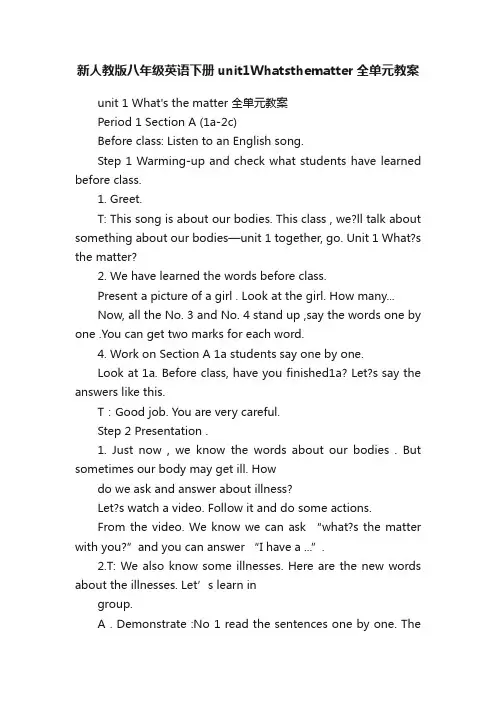
新人教版八年级英语下册unit1Whatsthematter全单元教案unit 1 What's the matter 全单元教案Period 1 Section A (1a-2c)Before class: Listen to an English song.Step 1 Warming-up and check what students have learned before class.1. Greet.T: This song is about our bodies. This class , we?ll talk about something about our bodies—unit 1 together, go. Unit 1 What?s the matter?2. We have learned the words before class.Present a picture of a girl . Look at the girl. How many...Now, all the No. 3 and No. 4 stand up ,say the words one by one .You can get two marks for each word.4. Work on Section A 1a students say one by one.Look at 1a. Before class, have you finished1a? Let?s say the answers like this.T:Good job. You are very careful.Step 2 Presentation .1. Just now , we know the words about our bodies . But sometimes our body may get ill. Howdo we ask and answer about illness?Let?s watch a video. Follow it and do some actions.From the video. We know we ca n ask “what?s the matter with you?”and you can answer “I have a ...”.2.T: We also know some illnesses. Here are the new words about the illnesses. Let’s learn ingroup.A.Demonstrate :No 1 read the sentences one by one. Theothers follow him/ her. When you read ,please do some actions like me.Let me see which group read best and act best.B. Study in groups.C. Find the rules.D. Group report. Stop studying, look at these words , what can you find?You are good at thinking.Step 3 Guessing game:Have you remember the words? Let?s play a guessing game. No 6 come here.quickly. You each act an action. (边说边发纸条)Each group have chances toguess the illness. The others answer like this: “He /She has a...”Step 4 Work on 1b.1. T: Now, you know some illnesses . Look at the picture .These students ger ill. Show thepictures one by one and ask.What are their names? Let?s do 1b.How do we do it? For example, we?ll hear Sarah has a cold, and No 1 has a cold , so write 1 behind Sarah. What about 2, 3, 4 and 5? When you hear the illnesses , write their numbers behind the names.2. Listen.3. Check the answers.。
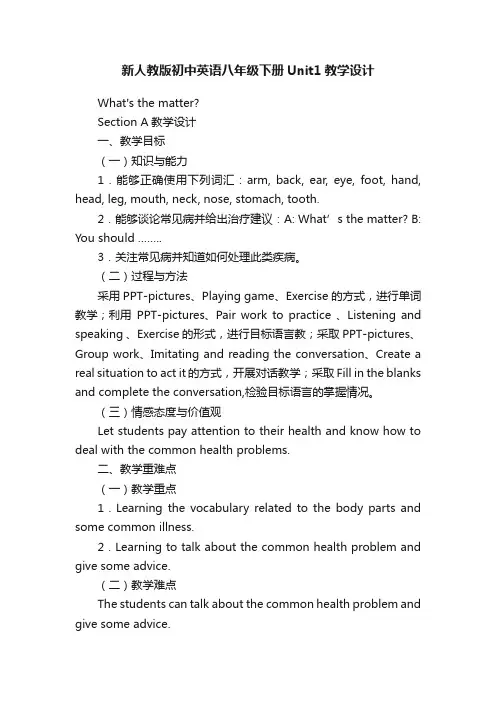
新人教版初中英语八年级下册Unit1教学设计What's the matter?Section A教学设计一、教学目标(一)知识与能力1.能够正确使用下列词汇:arm, back, ear, eye, foot, hand, head, leg, mouth, neck, nose, stomach, tooth.2.能够谈论常见病并给出治疗建议:A: What’s the matter? B: You should ……..3.关注常见病并知道如何处理此类疾病。
(二)过程与方法采用PPT-pictures、Playing game、Exercise的方式,进行单词教学;利用PPT-pictures、Pair work to practice 、Listening and speaking 、Exercise的形式,进行目标语言教;采取PPT-pictures、Group work、Imitating and reading the conversation、Create a real situation to act it的方式,开展对话教学;采取Fill in the blanks and complete the conversation,检验目标语言的掌握情况。
(三)情感态度与价值观Let students pay attention to their health and know how to deal with the common health problems.二、教学重难点(一)教学重点1.Learning the vocabulary related to the body parts and some common illness.2.Learning to talk about the common health problem and give some advice.(二)教学难点The students can talk about the common health problem and give some advice.三、教学策略1.Listening skills──Before listening to the dialogue, the students read the questions and predict.2.The students work in pairs or groups in order to practice speaking.四:教学过程Step1:The words related to the body partsActivity1:Game time:Follow me【设计意图】教师说出不同身体部位的单词,学生反映出来并进行相应的动作。
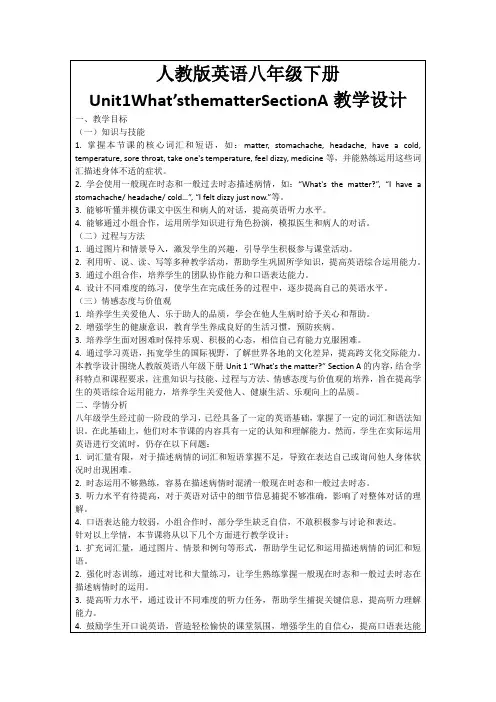
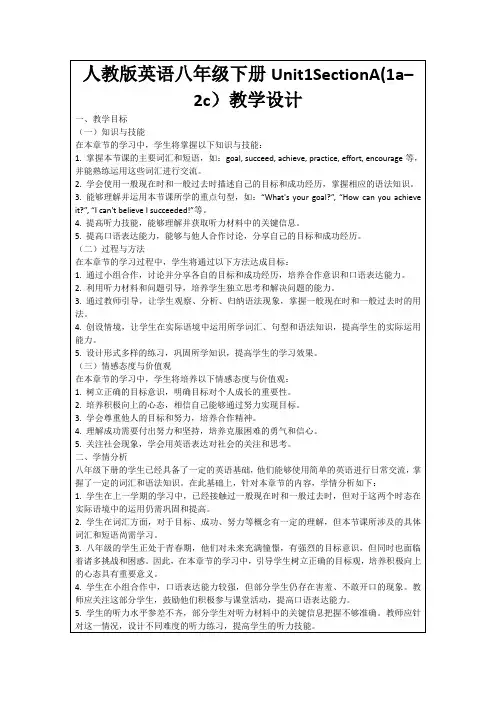
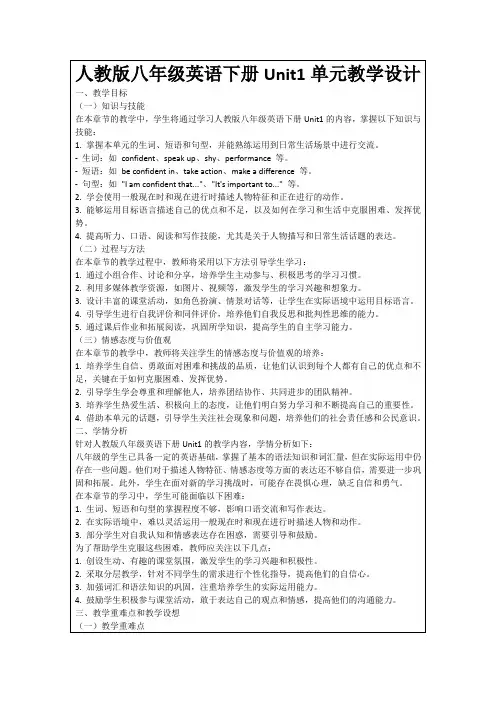
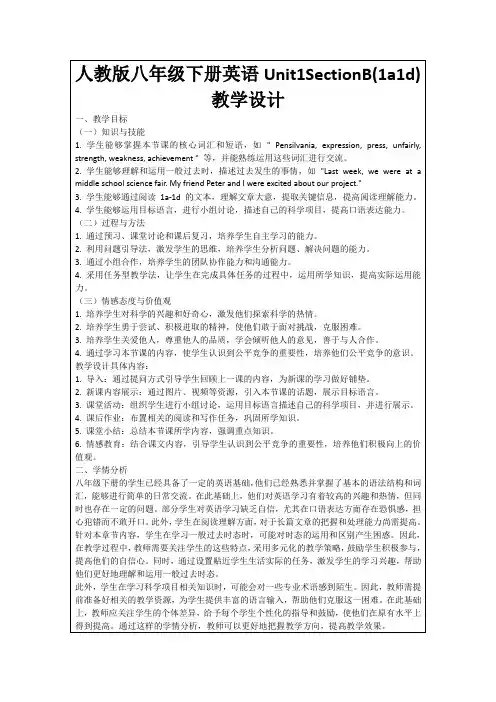
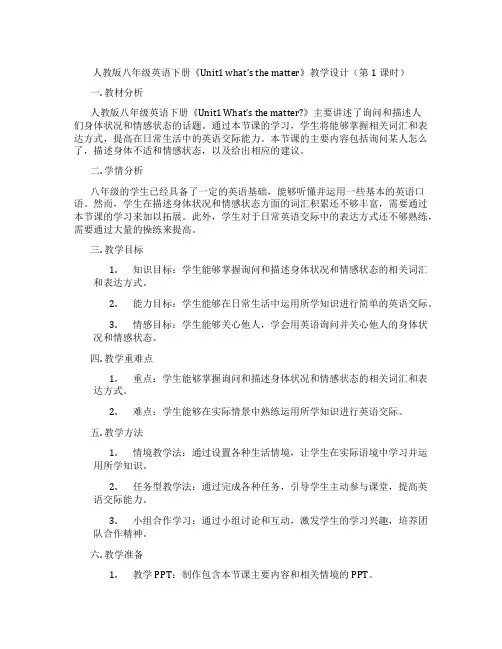
人教版八年级英语下册《Unit1 what’s the matter》教学设计(第1课时)一. 教材分析人教版八年级英语下册《Unit1 What’s the matter?》主要讲述了询问和描述人们身体状况和情感状态的话题。
通过本节课的学习,学生将能够掌握相关词汇和表达方式,提高在日常生活中的英语交际能力。
本节课的主要内容包括询问某人怎么了,描述身体不适和情感状态,以及给出相应的建议。
二. 学情分析八年级的学生已经具备了一定的英语基础,能够听懂并运用一些基本的英语口语。
然而,学生在描述身体状况和情感状态方面的词汇积累还不够丰富,需要通过本节课的学习来加以拓展。
此外,学生对于日常英语交际中的表达方式还不够熟练,需要通过大量的操练来提高。
三. 教学目标1.知识目标:学生能够掌握询问和描述身体状况和情感状态的相关词汇和表达方式。
2.能力目标:学生能够在日常生活中运用所学知识进行简单的英语交际。
3.情感目标:学生能够关心他人,学会用英语询问并关心他人的身体状况和情感状态。
四. 教学重难点1.重点:学生能够掌握询问和描述身体状况和情感状态的相关词汇和表达方式。
2.难点:学生能够在实际情景中熟练运用所学知识进行英语交际。
五. 教学方法1.情境教学法:通过设置各种生活情境,让学生在实际语境中学习并运用所学知识。
2.任务型教学法:通过完成各种任务,引导学生主动参与课堂,提高英语交际能力。
3.小组合作学习:通过小组讨论和互动,激发学生的学习兴趣,培养团队合作精神。
六. 教学准备1.教学PPT:制作包含本节课主要内容和相关情境的PPT。
2.教学素材:准备一些描述身体状况和情感状态的图片或卡片。
3.教学录音设备:用于播放听力材料。
七. 教学过程1.导入(5分钟)教师通过播放一段关于人们描述身体状况和情感状态的听力材料,引导学生关注本节课的主题。
同时,教师可以提问学生:“Can you guess what’s the matter with them?”,激发学生的学习兴趣。
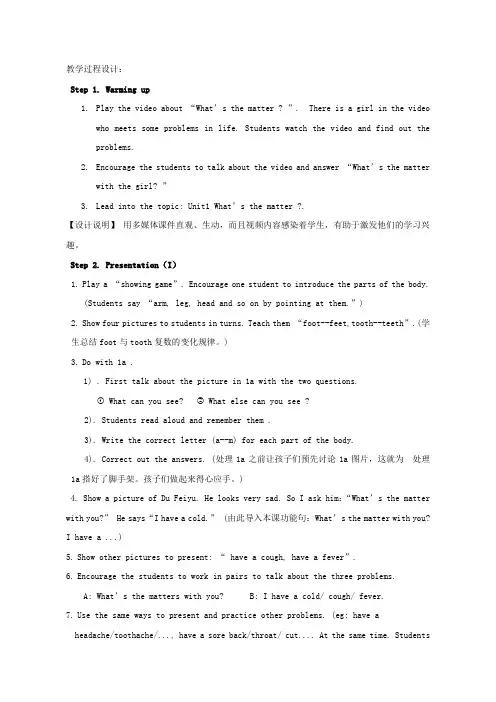
教学过程设计:Step 1. Warming up1.Play the video about “What’s the matter ? ”. There is a girl in the videowho meets some problems in life. Students watch the video and find out theproblems.2.Encourage the students to talk about the video and answer “What’s the matterwith the girl? ”3.Lead into the topic: Unit1 What’s the matter ?.【设计说明】用多媒体课件直观、生动,而且视频内容感染着学生,有助于激发他们的学习兴趣。
Step 2. Presentation(I)1.Play a “showing game”. Encourage one student to introduce the parts of the body.(Students say “arm, leg, head and so on by pointing at them.”)2.Show four pictures to students in turns. Teach them “foot--feet,tooth--teeth”.(学生总结foot与tooth复数的变化规律。
)3.Do with 1a .1) . First talk about the picture in 1a with the two questions.① What can you see? ② What else can you see ?2). Students read aloud and remember them .3). Write the correct letter (a--m) for each part of the body.4). Correct out the answers. (处理1a之前让孩子们预先讨论1a图片,这就为处理1a搭好了脚手架。
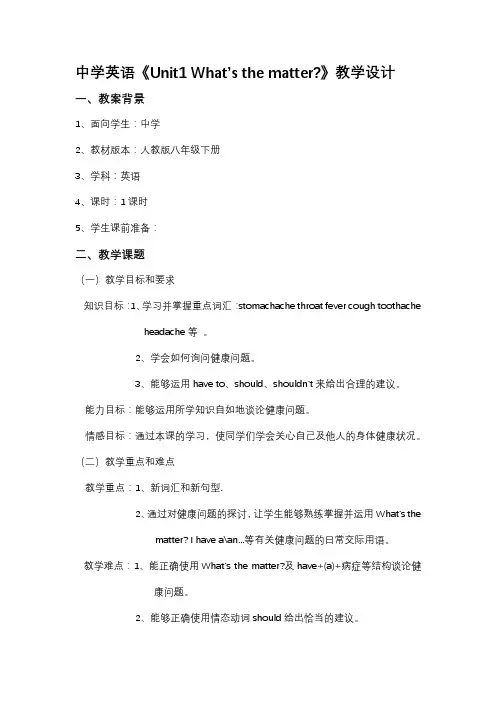
中学英语《Unit1 What’s the matter?》教学设计一、教案背景1、面向学生:中学2、教材版本:人教版八年级下册3、学科:英语4、课时:1课时5、学生课前准备:二、教学课题(一)教学目标和要求知识目标:1、学习并掌握重点词汇:stomachache throat fever cough toothache headache等。
2、学会如何询问健康问题。
3、能够运用have to、should、shouldn't来给出合理的建议。
能力目标:能够运用所学知识自如地谈论健康问题。
情感目标:通过本课的学习,使同学们学会关心自己及他人的身体健康状况。
(二)教学重点和难点教学重点:1、新词汇和新句型.2、通过对健康问题的探讨,让学生能够熟练掌握并运用What’s thematter? I have a\an...等有关健康问题的日常交际用语。
教学难点:1、能正确使用What’s the matter?及have+(a)+病症等结构谈论健康问题。
2、能够正确使用情态动词should给出恰当的建议。
三、教材分析本节课选自人教版八年级下第一单元“What’s the matter? ”的section A部分.本单元通过对健康这一人们生活中必不可少话题的谈论,让学生们学会关于谈论健康状况的一些日常交际用语。
在本课的教学过程中也会通过对表述身体不适句型结构的分析以及情态动词should一词的讲解,让学生进一步掌握有关伤病及处理建议的表达方式。
本节课的教学重点在于对新单词和句型的熟练掌握,只有熟练的掌握才能自如的运用。
难点在于将所学知识熟练的运用,并且能够根据不同的健康问题给予合理的建议。
在教学准备过程中我搜索到了一些与本课相关的能够令学生们感兴趣的图片、录音,寓教于乐让学生们积极的参与到教学过程中,让他们能够充分体会到学习的快乐。
调动他们学习英语的积极性,充分展示学生在教学中的主体地位。
四、教学方法运用task-based method(任务型教学法),借助多媒体手段创设情境让学生产生兴趣,而积极主动的投入到语言环境中。
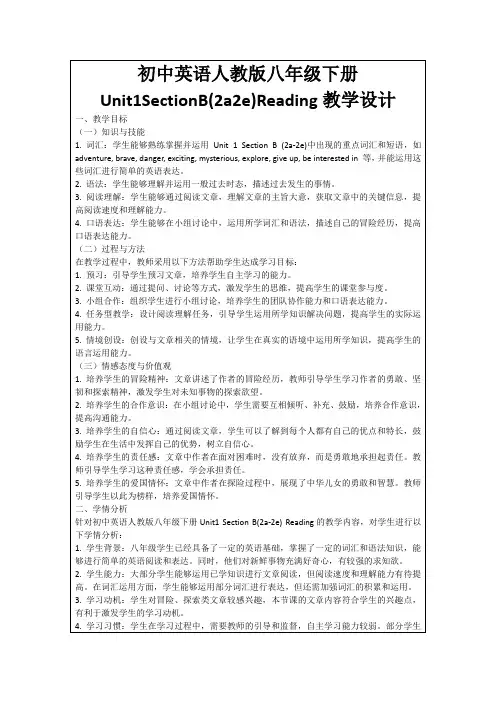
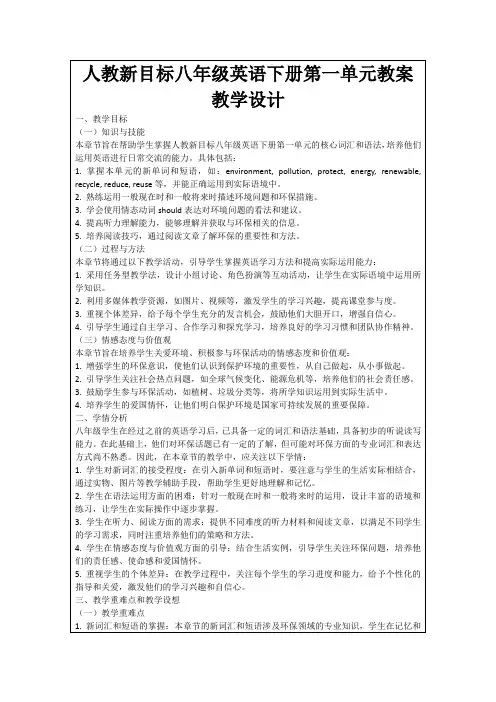
新人教版八年级英语下册Unit1(1)教案新人教版八年级英语下册Unit1(1)教案课题Unit 1 What’s the matter?课型New lesson 教学内容Section A1 (1a – 2d)教学目标1.语言知识目标:描述健康问题词汇,及如何根据别人健康问题提建议。
2.技能目标:能听懂谈论健康问题的对话材料;能根据别人的健康问题提建议;能写出重点单词和重点句型,并能描述怎样对待健康问题。
3.情感态度价值观目标:通过开展扮演病人等活动,培养学生关心他人身体健康的品质。
通过本课的阅读,培养学生处理紧急事件的基本能力,树立紧急事件时互相帮助的精神。
教学重点(1)、短语:have a st omachache, have a cold, lie down, take one’stemperature, go to a doctor, get off, to one’s surpr ise, agree to do sth., get into trouble, fall down, be used to, run out (of), cut off , get out of, be in control of , keep on (doing sth.), give up(2)、句子:—What’s the matter?—I have a stomachache.—You shouldn’t eat so much next time.(3)、根据别人健康问题提建议。
教学难点(1)、掌握情态动词should / shouldn’t. 用法;(2)、学习have的用法教学方法Explanation, Oral English & Listening Practice & English Writing教具准备PPT, tape recorder.教学过程Step 1 Warming up and new words:1. Look at a picture and learn the parts of the body.2. New words and phrases.Step 2 Presentation:1a. Look at the picture. Write the correct letter [a-m] for each part of the b ody.___arm ___ back ___ ear ___ eye ___ foot ___hand ___ head ___ leg ___ mouth ___ neck ___nose___ stomach ___ toothStep 3 Listening:1b. Listen and look at the picture. Then number the names 1-5.Listen to the conversations again and fill in the blanks.Conversation 1Girl: I ___________.Conversation 2Boy: I _________________.Conversation 3Boy: I _________________.C onversation 4Girl: I _________________.Conversation 5Betty: What’s the matter, Judy?Ann: She __________________.Step 4 Speaking:1c. Look at the pictures. What are the students’ problems? Make conversations.A: What’s the matter with Judy?B: She talked too much yesterday and didn’t drink enough water. She hasa very sore throat now.A: What’s t he matter with Sarah?B: She didn’t take care of herself on the weekend. She was playing with herfriends at the park yesterday. Then it got windy, but she didn’t put on herjacket. Now she has a cold.Step 5 Guessing games:Guess what has happened to the students by using the important sentences. Step 6 Listening:2a. Listen and number the pictures [1-5] in the order you hear them.2b. Listen again. Match the problems with the advice.Step 7 Speaking:2c. Make conversations using the information in 2a and 2b.A: What’s the matter?B: My head feels very hot.A: Maybe you have a fever.B: Wha t should I do?A: You should take your temperature.Step 8 Role–play:Imagine you are the school doctor. A few students have health problems.Role-play a conversation between the doctor and the students.2d. Role –play the conversationStep 9 Language points and summary:1. What’s the matter?What’s wrong? 怎么啦?What’s wrong with you? 你怎么了?What’s y our trouble? 你怎么了?What’s the trouble with you?你怎么了?What’s up? 你怎么了?2. have a cold 伤风, 感冒表示身体不适常用词组还有:have a bad cold重感冒have a fever 发烧have a headache头痛have a stomachache 肚子痛, 胃痛have a toothache牙痛have a backache 背疼have a sore throat 喉咙疼have a fever发烧lie down and rest 躺下休息drink hot tea with honey 喝热蜂蜜茶drink lots of water喝大量水see a dentist看牙医go to a doctor看医生take one’s temperature 量体温Step 10 Exercises:(一)、根据上下文意思填空。
新人教版八年级下册初中英语全册教案(教学设计)一. 教学目标本教案旨在帮助八年级学生掌握下册初中英语的相关知识和技能,包括听、说、读、写四个方面的能力提高。
二. 教学内容本教案涵盖了全册的教学内容,包括以下单元和主要教学点:1. Unit 1: Meeting New Friends- 语言点:be动词的一般现在时- 活动:介绍新朋友- 阅读:了解文化差异2. Unit 2: The First Day at School- 语言点:一般过去时- 活动:描述第一天上学的经历- 阅读:理解校园规则3. Unit 3: I Love Reading- 语言点:情态动词can和must - 活动:介绍喜欢的书籍- 阅读:阅读理解4. Unit 4: My School Life- 语言点:形容词比较级和最高级- 活动:描述学校生活的不同方面- 阅读:了解不同的学校生活5. Unit 5: Our Future Jobs- 语言点:职业相关词汇- 活动:谈论未来的职业- 阅读:了解不同的职业6. Unit 6: Weather and Climate- 语言点:天气相关词汇和短语- 活动:讨论天气和气候- 阅读:了解不同地区的气候7. Unit 7: Enjoy Your Trip- 语言点:旅行相关词汇和短语- 活动:计划和描述旅行- 阅读:阅读旅行指南8. Unit 8: At the Farm- 语言点:动词的现在进行时- 活动:描述在农场的经历- 阅读:了解农场生活三. 教学方法本教案使用多种教学方法,包括但不限于:听力练、口语对话、阅读理解、小组讨论、写作练等。
教师将根据具体情况选择合适的教学方法进行教学。
四. 教学步骤1. 引入新课,激发学生兴趣。
2. 执行听力练以提高学生听力能力。
3. 进行口语对话练,帮助学生提高口语表达能力。
4. 进行阅读理解练,加深学生对课文的理解。
5. 进行小组讨论,让学生互相交流观点。
人教版英语八年级下册Unit1 What’s the matter ?Section A(1a-2d)一、教学目标设计(1)知识目标a. 词汇:人体部位名称如:arm,ear,head, back, stomach, neck, mouth等, 身体疾病名称如: stomachache,fever, cough and sore throat,fever, toothache,headache 等以及其他相关词语。
b. 句型: What’s the matter?I have a cold/…You should/ shouldn’t …(2)能力目标a. 能掌握询问疾病与表示身体不适的话语。
b. 能口头与他人对话健康问题并给出合理建议。
(3)情感态度目标通过询问病情与提供合理建议,培养关心他人、助人为乐的美德。
二、教学重点(1)词汇:人体部位名称如:arm,ear,head,back, stomach, neck, mouth等,身体疾病名称如:stomachache,cough and throat,fever, toothache, headache, take one’s temperature等以及其他相关词语.(2)句型: What’s the matter?I have a cold/…You should/ shouldn’t …三、教学难点should/ shouldn’t 在模拟情景中灵活使用.四.教学过程Step 1 Warming-upLet students listen to Body-Song and sing the song together:Why can we see with our eyes?Why can we hear with our ears?Why can we speak with our mouth?Why can we smell with our nose?Why can we write with our hands?Why can we walk with our legs?Why? Why? Why?Will you tell me why?Step 2 presentationShow a picture of a baby on the screen and teach the words of body parts.Let students read the following words loudly .Step 3 CompetitionPresent three picture of three persons on the blackboard and choose three pairs to the blackboard. They need to find the cards with body words and stick more on the body parts quickly and correctly. The student who stuck to the picture more and correctly is the winner.Step 4 Game: Poly saysT: Poly says “touch your head/foot…”All students stand up and touch their body parts. If somebody does wrong, he/she has to sit down.Step 5 PresentationT: Today I’m not feeling well. What’s the matter ? Oh, I have a cold. Then show the pictures of other common illnesses and repeat the new words. Make sure every student knows the meaning and can read them. (板书cold, stomachache, sore throat, fever,toothache,headache)Step 6 Pair workAsk students to look at the pictures of illnesses on the screen and practice the conversations like 1 c. Afterthat,have several pairs of students act out their conversations to the class (one student answers and mimes the illness).Then choose the best pair and praise.Step 7 Group work1.T:I do exercise every day but today I can’t. Can you guess why I can’t?Ss: Maybe you have a cold/…T: You are so clever. I have a fever. What should I do? Please give me some advice.Ss: You should…/ You should n’t …2.T: Let’s guess (choose two or three pieces of paper from the box ) and give advice. The group discusses together and chooses a leader to present their advice on the slide. The group who gives more and better advice is the winner. Step 8 Role play : A magic doctorImagine the classroom is the doctor’s waiting room. Get several students as magic doctors. Ask about illnesses and give advice for different illnesses.S1(the doctor): What’s the matter (with you)?S2(a patient): I’m not feeling well. I have a stomachache. ( perform the illness)S1: You should take some medicine/ You should n’t eat too much, etc.S2: Yes, I think so. / That’s a good idea.S1: I hope you feel better soon.Step 9 watch a videoShow a video “To wash mother’s feet” to feel the love from our familyStep10 homework1.Revise the words and phrases.2.we all know, parents make enormous contribution to the family and they sacrifice a lot for us.(父母为家庭做出了贡献,为我们付出了很多)Ask your parents about their health,is there anything wrong with their bodyparts?What should you do ?Then today try to do something for them.Blackboard designUnit 1 What’s the matter ?Section AA: What’s the matter ( with you ) ?B: I have a __________(illness).A: You should / shouldn’t …。
What's the matter?Section A教学设计一、教学目标(一)知识与能力1.能够正确使用下列词汇:arm, back, ear, eye, foot, hand, head, leg, mouth, neck, nose, stomach, tooth.2.能够谈论常见病并给出治疗建议:A: What’s the matter? B: You should ……..3.关注常见病并知道如何处理此类疾病。
(二)过程与方法采用PPT-pictures、Playing game、Exercise的方式,进行单词教学;利用PPT-pictures、Pair work to practice 、Listening and speaking 、Exercise的形式,进行目标语言教;采取PPT-pictures、Group work、Imitating and reading the conversation、Create a real situation to act it的方式,开展对话教学;采取Fill in theblanks and complete the conversation,检验目标语言的掌握情况。
(三)情感态度与价值观Let students pay attention to their health and know how to deal with the commonhealth problems.二、教学重难点(一)教学重点1.Learning the vocabulary related to the body parts and some common illness.2.Learning to talk about the common health problem and give some advice.(二)教学难点The students can talk about the common health problem and give some advice.三、教学策略listening to the dialogue, the students read the 1.Listening skills──Beforequestions and predict.2.The students work in pairs or groups in order to practice speaking.四:教学过程Step1:The words related to the body partsActivity1:Game time:Follow me【设计意图】教师说出不同身体部位的单词,学生反映出来并进行相应的动作。
通过这个活动,让学生以实物接触词汇,不但印象深刻而且在上课开始阶段,引起学生学习兴趣。
Activity2:Learning the following words with the help of the pictures.等arm, back, ear, eye, foot, hand, head, leg, mouth, neck, nose, stomach, tooth【设计意图】利用图片,形象直观的表达每一个单词,引起学生兴趣,便于理解和记忆。
Activity3:课本1a look at the picture, write the correct letter for each part of the body.____arm ____back ____ear ____eye ____foot ____hand ____head ____leg____mouth ____neck ____nose ____stomach ____tooth【设计意图】检验学生对所学单词的认知情况。
Activity4:Exercise:Name the parts of the words.1. You smell with your _______.2. You hear with your ____________.3. The __________ is a symbol of love.4. You need to know these sizes when you buy a man’s shirt. ____________5. You need to know these sizes when you buy jeans or trousers. _________6. You play the guitar with them. ______7. The place where your leg bends. ____8. The place where your arm bends. ___【设计意图】通过阅读句型,理解句型,写出相应的的单词,进一步巩固单词的中文意思和拼写。
Activity5:课本1b listen and look at the picture .Then number the names.【设计意图】通过模仿朗读句型,使学生初次接触本节课目标语言,并展示某种疾病状态,由此引出本课重点句型。
Step 2:learning target languageWhat’s the matter?You should ……..Activity1:利用图片引出各种常见病,学会询问和表达疾病名称,并反复操练,使学生逐步掌握并巩固。
【设计意图】通过图片直观地展示各种常见病,教会学生询问并表达的疾病,并利用图片反复操练,做到孰能生巧。
Activity2:利用图片引出常见病的简单治疗方式,当给别人提建议时,使用should/shouldn’t,反复操练使学生逐步掌握。
【设计意图】通过图片直观地展示各种常见病的相应治疗方式,教会学生为病人提出合理建议,并利用图片反复操练,做到孰能生巧。
Activity3:2a Listen and number the pictures in the order you hear them.2b Listen again. Match the problems with the advice【设计意图】通过听对话的形式,再现了各种疾病的名称和治疗建议,达到巩固这些知识点的目的。
另外,在听力训练之前,让学生猜测答案,然后从听力中获取正确的信息,再订正答案,这样做也能提高学生学习兴趣,同时为学生的进一步的学习做铺垫。
Activity4:2c Make conversations using the information in 2a and 2bA: What’s matter?B: My head feels very hot.A: Maybe you have a fever….B: ……【设计意图】通过让学生进行对话练习,理解目标语言如何使用。
Activity 5:2d Role-play the conversation跟读,朗读对话,并理解中文意思。
【设计意图】通过跟读朗读对话,进一步巩固目标语言。
Step 3:Create the real situation to practiceActivity 1:分角色朗读2d,并让学生把身体不适和所提建议表演出来。
【设计意图】首先利用对话,创设相对简单的语言情境,使学生感知真实语言情景下的教学,能够轻松地理解、掌握新知识,符合学生的认知,增强教学的实效性,并为学生模仿语言和进一步拓展该话题提供了示范。
Activity 2:Create the real situation and act it out.例如:Now you’re working in a hospital, you are “Dr. Know”, give the patientssome good advice.学生之间互动,如一排病人一排医生,一边看病一边纪录,看谁的建议好。
A: What’s the matter?B: I have a sore throat /…A: Maybe you should drink lots of water and……B: That’s a good idea.…….【设计意图】为学生创设真实语言情景,让学生自由发挥,尝试用所学语言表达自己的真实想法,让学生实践所学语言在真实语境中的使用,从模仿语言过渡到运用语言,达到本节课的教学目标。
Step 4:Quiz4a Fill in the blanks.4b Circle the best advice for these health problems. Then add your own advice.【设计意图】笔头巩固所学知识,并进行当堂检测,了解学生掌握知识情况,便于设计下一节课。
Step5:Homework1. Recite the new words related to the parts of the body.2. Make up 3 conversations about the common illness and give some advice.3. Finish the related exercises in the workbook.【设计意图】再一次巩固本节课所学词汇和句型。
(补充材料可以用作英语课堂笔记,这样不仅再次强调了重点,而且满足了不同层次学生的需要。
)Section B教学设计1教学内容本节课是人教新目标Go for it ( 八年级下 ) Unit 1的内容。
本节课课型为阅读,本课时主要介绍了 Aron Ralston 面对危机的勇气和智慧。
通过学生的自主、合作、探究,扫除学生的语义障碍,增强学生对篇章的理解能力,拓展学生梳理文本结构的能力,并综合锻炼了学生的听说和写作能力。
在说的部分,让学生通过把材料的内容与最近一直强调的安全教育联系起来,在实际生活情景中使用本单元所学的提出建议与决定的知识,以及从Aron Ralston的故事中所学到的优秀品质。
2课程标准学生能从文章中找出信息,理解大意;能在小组活动中积极与他人合作,相互帮助,共同完成学习任务。
3教学目标1.知识目标:a.掌握本部分新词汇(如:climber, risk, accident, importance, spirit , death, decision, mean等)b.理解并掌握重点句型:(如:be used to ..., use sth to do sth . the importance of sth/doing sth等).2.能力目标:a.运用扫读和细读的阅读技巧,完成对语篇的大意理解,了解 Aron Ralston 遇险的时间、地点、怎样脱险、脱险后的表现等基本信息。